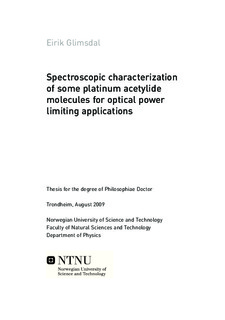| dc.contributor.author | Glimsdal, Eirik | nb_NO |
| dc.date.accessioned | 2014-12-19T13:16:17Z | |
| dc.date.available | 2014-12-19T13:16:17Z | |
| dc.date.created | 2009-08-26 | nb_NO |
| dc.date.issued | 2009 | nb_NO |
| dc.identifier | 233280 | nb_NO |
| dc.identifier.isbn | 978-82-471-1723-1 (printed version) | nb_NO |
| dc.identifier.isbn | 978-82-471-1725-5 (electronic version) | nb_NO |
| dc.identifier.uri | http://hdl.handle.net/11250/246245 | |
| dc.description.abstract | The rapid development of laser technology results in new and powerful lasers operating at a variety of wavelengths. At the same time lasers have found its use in many electronic devices and instruments used in both civilian and military applications. However, lasers are also found to be an effective threat for blinding and destroying optical sensors. Therefore, the need for useful protection devices has increased. A protective device, constructed from nonlinear absorbing materials, can absorb the high intensity light, while at the same time keeping the device transparent for normal operation of the sensor. In this thesis, a series of square planar trans-diarylalkynyl-bis(tributyl-phosphine) platinum(II) complexes have been investigated for their photo-physical properties and optical power limiting (OPL) capabilities. The main objectives have been to establish methodologies for characterization of quantum efficiency, twophoton absorption cross section and excited state absorption of triplet states. These methods were applied along with absorption and time-resolved luminescence spectroscopy and OPL to characterize new materials. Also, the photophysical characterization of a series of three Coumarin molecules suitable for reference purposes in the determination of quantum efficiencies and two-photon absorption cross sections of new samples are presented (Paper VI).
For the compounds investigated in Paper I and II, thiophene groups and methoxy substituents were inserted into the structure in an attempt to increase the nonlinear properties and OPL capabilities compared to a pure phenylcontaining analogue. In Paper III, a new synthetic route was developed for the compounds utilizing the click chemistry method through triazole formation. The introduced thiophene and triazole units were placed at different positions in the structure to investigate its effect on the photo-physical properties. Placed at different positions in the structure, the new rings were found to affect the conjugation of the ligands. Spectral shifts and shorter phosphorescence lifetimes were observed as the rings were placed closer to the Pt-atom.
In Paper IV the important triplet state absorption and relaxation processes were investigated for all compounds in Paper I− III, together with four new molecules. Methyl substituents were inserted as a means to control the ligand rotation, and a molecule with two different ligands were prepared to investigate the effect on the optical properties from a non-symmetric compound. Excited state absorption from the triplet state was found to be strong for all molecules, with extinction coefficients in the range 1 − 10 · 104 M−1 cm −1. In Paper V, some of the molecules were incorporated into solid PMMA glasses. The photo-physical properties of the compounds in both low and high concentrated PMMA glasses were investigated and compared to similar samples prepared in solution. New excitation bands were observed at high concentrations both in liquid and solid state. Finally, using a pulse-propagation simulation method, the OPL performance of materials with photo-physical parameters typical for the investigated molecules, were examined. It was found that the triplet excited state absorption is the dominating process in operation around 532 nm for 5 ns pulses.
| nb_NO |
| dc.language | eng | nb_NO |
| dc.publisher | Norges teknisk-naturvitenskapelige universitet, Fakultet for naturvitenskap og teknologi, Institutt for fysikk | nb_NO |
| dc.relation.ispartofseries | Doktoravhandlinger ved NTNU, 1503-8181; 2009:165 | nb_NO |
| dc.title | Spectroscopic characterization of some platinum acetylide molecules for optical power limiting applications | nb_NO |
| dc.type | Doctoral thesis | nb_NO |
| dc.contributor.department | Norges teknisk-naturvitenskapelige universitet, Fakultet for naturvitenskap og teknologi, Institutt for fysikk | nb_NO |
| dc.description.degree | PhD i fysikk | nb_NO |
| dc.description.degree | PhD in Physics | en_GB |

